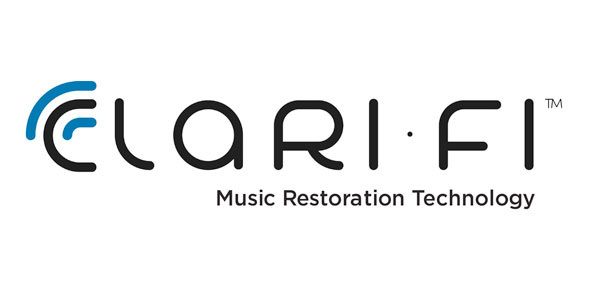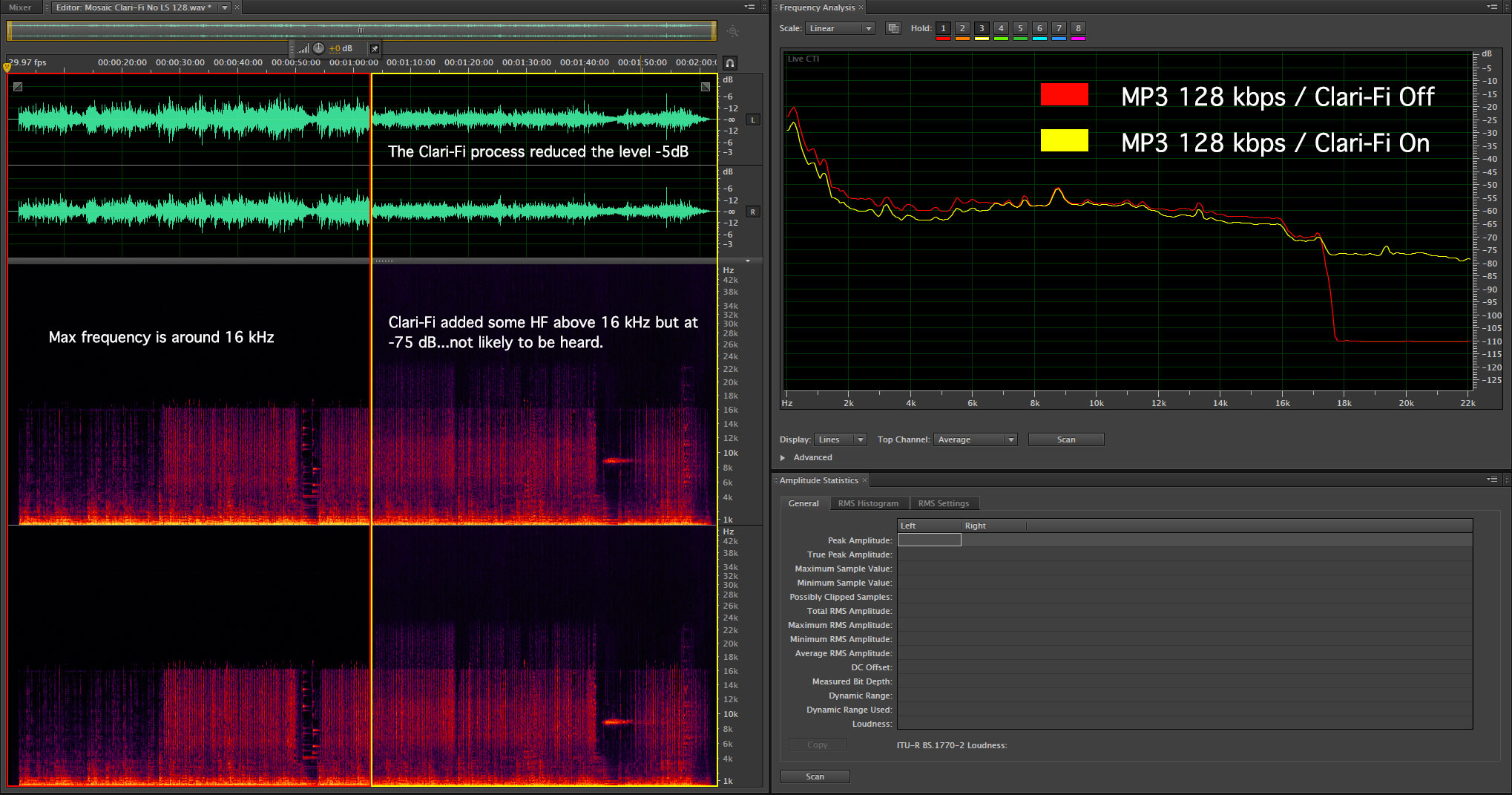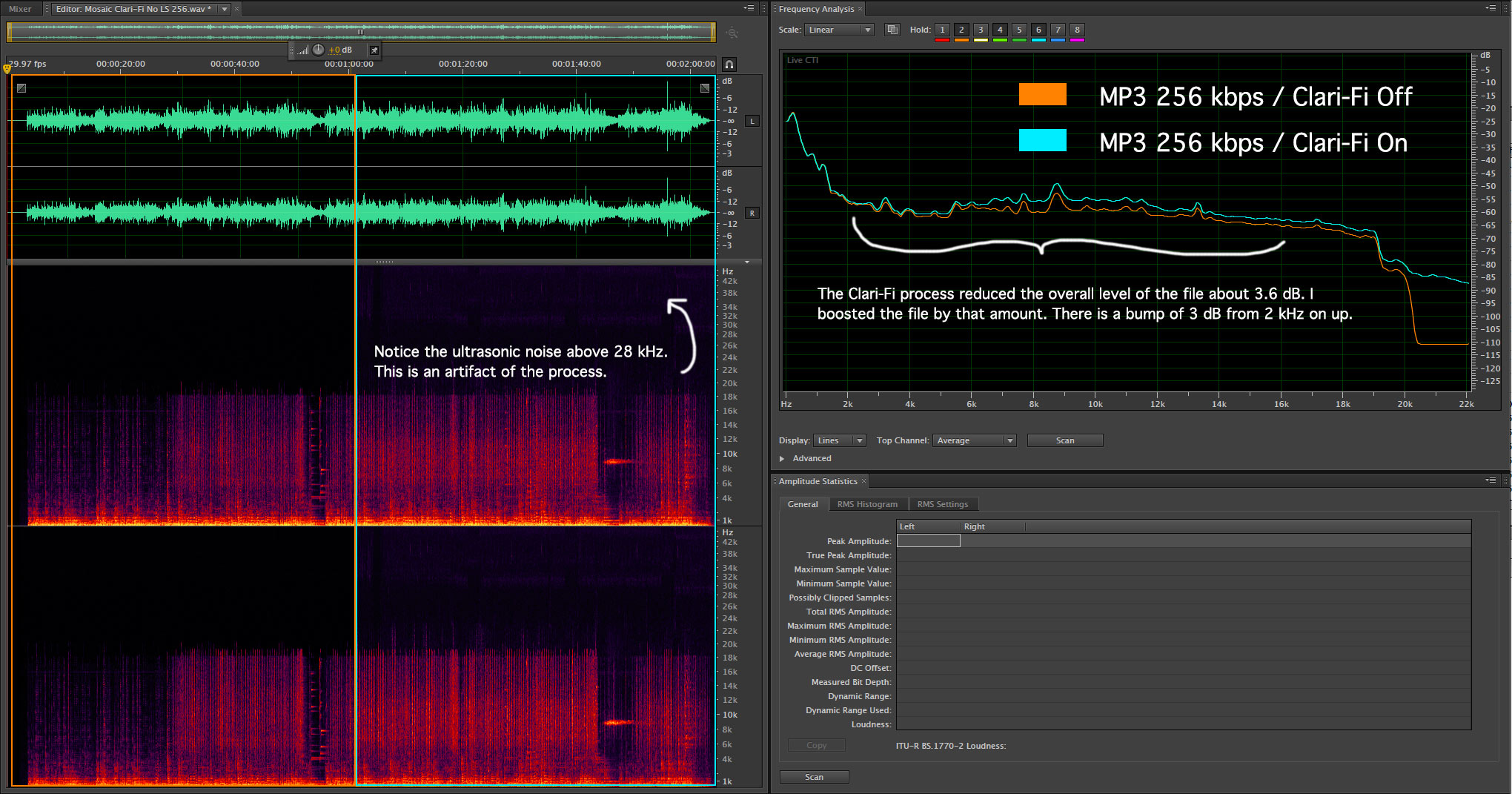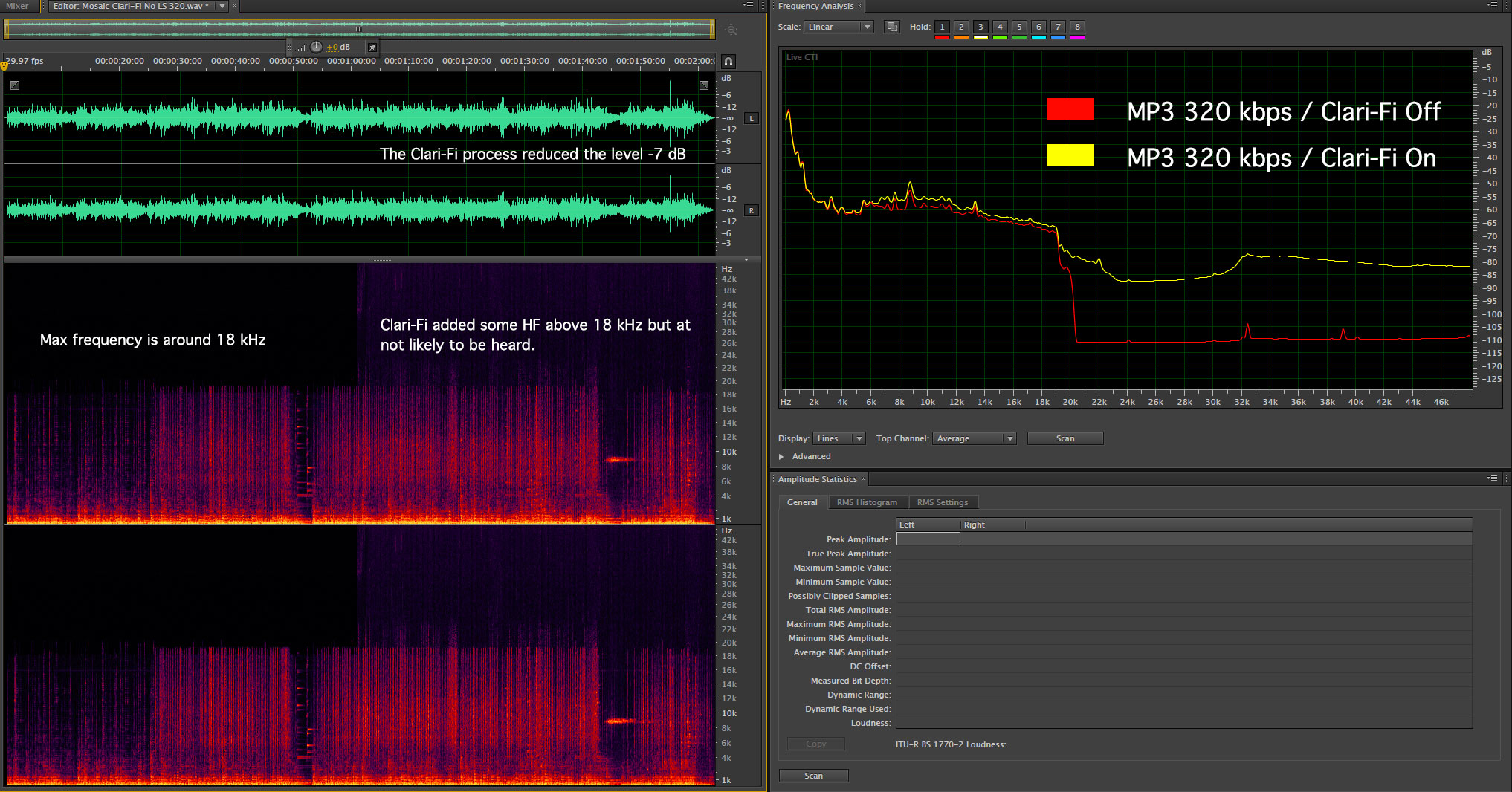Rescuing MP3 Files
I wanted to continue the discussion that I started the other day (click here to read it) about algorithms that attempt to “restore” the sound of an MP3 back to their original “pre-encoded” fidelity. The initial analysis was performed on my “Mosaic” track encoded at 96 kbps. Today, I would like to show what happens when the same track is encoded at a higher rate…at 128, 256 or even the 320 kbps rate.
The Apple iTunes store (and most other digital music download stores) used 128 kbps as the standard bitrate for their music downloads. These days that rate has been pushed up to 256 kbps…so the likelihood that anyone is purchasing files at 96 or 128 is pretty slim. I just downloaded the “Happy” song by Pharrel Williams (I loved the “Despicable Me” movie and thought this tune was a perfect match for the story). It’s a typical overmastered, commercial hit with limited dynamic range (34 dB), but is a vast improvement on the days of 96 kbps.
So what does the Harman Kardon Clari-Fi technology do when presented with a 128 kbps MP3 version of “Mosaic”? Take a look:
Figure 1 – Spectrum of “Mosaic” encoded as an MP3 file at 128 kbps with and without Clari-Fi. [Click to enlarge]
There are a couple of notable points about this level of MP3 and the Clari-Fi process. The first is the lowering of the amplitude. It’s almost 5 dB quieter than the original MP3 file. I don’t know why this would happen. Perhaps the designers are concerned about some of the new frequencies exceeding the limit? The second thing is that while the high frequency slope of the plot is extended in the Clari-Fi example, there is a boost in the 5-12 kHz region that would “enhance” the sound. I’m not sure the addition of frequencies between 18 – 20 kHz is meaningful in this case. Listeners will most likely experience a difference due to the “equalization” differences.
Again, the process doesn’t address the most critical damage that lossy algorithms inflict…the removal of low level partials that are masked by the louder sounds.
Here’s the spectrum for the 256 kbps example:
Figure 2 – Spectra of “Mosaic” encoded as an MP3 file at 256 kbps with and without Clari-Fi. [Click to enlarge]
There was 3.6 dB attenuation as a result of the Clari-Fi process AND a noticeable bump in the level above 2 kHz compared to the original MP3. At 256 kbps the encoded file is very close to CD Quality. It would be hard to distinguish them apart with moderate equipment or using an iPod or other portable player.
Finally, here’s the same thing at 320 kbps…the highest MP3 encoding level available for commercially downloadable files.
Figure 2 – Spectra of “Mosaic” encoded as an MP3 file at 320 kbps with and without Clari-Fi. [Click to enlarge]
So the folks at Harman are doing more or less the same thing in this example…boosting the levels of the mid to high frequencies. At this point, there’s really no need to talk about the increased high-end…since the original 320 MP3 file can deliver CD Quality.
So are these techniques meaningful or just another sales/marketing slogan? They do make an audible difference…more at the 96 or 128 kbps bitrates than the higher ones…but once you get to 256 or 320, you’re almost at CD Quality anyways so why bother?
If I had my way HTC and Sprint would play up the appeal of lossless audio at 96 kHz/24-bits to serious music listeners and let the MP3 crowd enjoy the great in-ear phones or powerful speakers on the front of the M8 phone. Clari-Fi is OK but not a big winner.





You can glean a lot of useful information from a spectrogram, but it doesn’t tell you terribly much about what this processing does. As a mastering engineer, I’m sure you appreciate all of the ways you can manipulate the sound of a track without appreciably changing the spectrogram. Maybe you could use your contacts to find out the basis behind the algorithm.
If it improves the subjective listening experience, this DSP is useful for the masses who have acquired a library of compressed music tracks over the past decade. Unlike audiophiles, they’re not likely to repurchase the same music to get higher fidelity, even if it’s offered. Further, if the processing works on the compressed streams of Pandora et al., It covers the current and future means of music distribution.
I do understand that there are many tweaks (both large and small) that a track can be submitted to…however, anything that changes the amplitude or dynamics of a track will be visible on a spectograph plot. Phase is another thing.
Hi Mark,
With the greatest of respect, I think this topic is unworthy of this website. Surely everybody who takes the time to visit your site and read your posts holds MP3 files right up there with the plague.
Sorry to sound brash, but MP3 is an insult, not only to the senses, but also the wallet.
Warren, I appreciate your comments. My point was to talk about the merits of restoration algorithms…because they can be used to enhance lots of different types of files…not just mP3s.
By today’s standards , just rrsample it to 24/192 and sell it for HiRez download prices. Provanace be danged.
You’re hired!
This post kind of reminds me of the (highly disappointing) Dolby B & C noise reduction technologies of way back when. I remember reading about those technologies before they were released and had high hopes. In reality I preferred to live with the noise rather than not being able to hear the high frequencies. Buying a Nakamichi Dragon tape machine left with a ripped off feeling as the noise “reduction”‘was actually sound reduction. A difference of 3 db is enough for my ear to notice easily and the Maxell dealer probably hated me because I’d complain about drop outs (maybe) more than the average customer. I don’t miss tape (metal, digital or others) nor do I miss LP’s (except the liner notes and art).
These technologies have always left me, at best, skeptical when announced. In the analog days whatever you started with was the best quality possible. Subsequent “generations” or copies decayed in quality. The kids today have it made in making their mix cd’s. It’s too bad few of them are aware of it.
I guess there is a possible market for people not wanting to spend money on upgrading their music files to higher resolution files. For me, it seems like the algorithm is trying to reduce the distortion of the encoding process by adding a different kind of distortion. It just doesn’t seem to be worth the engineering effort.
Years ago there was a Winamp plugin named Ozone, especially effective in restoring apparent audio quality with low bitrate music.
It did a remarkable job in restoring lower and higher frequencies, also letting the sound… sound more natural and pleasing to the ear by processing it with a virtual vacuum tube.
So I believe that sometimes these software tricks can really work.
Do you mind if I quote a few of your articles as long as I provide credit and sources back to your website? My blog is in the exact same niche as yours and my users would really benefit from a lot of the information you provide here. Please let me know if this ok with you. Cheers!
Fletcher…I have no problems with small sections being quoted from my articles. I do object if the entire substance of the posts and illustrations are “borrowed”. With credit and links, quotes are fine. Just let me know…